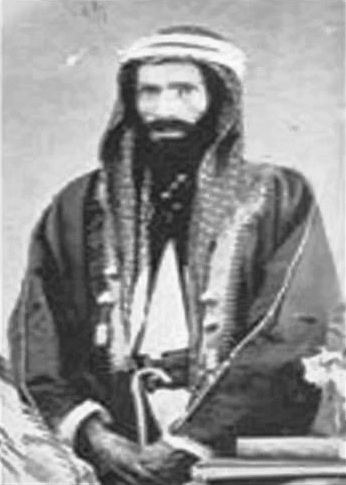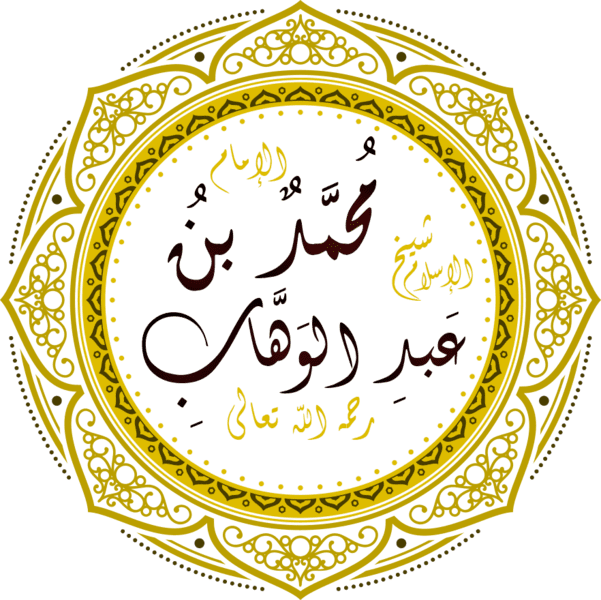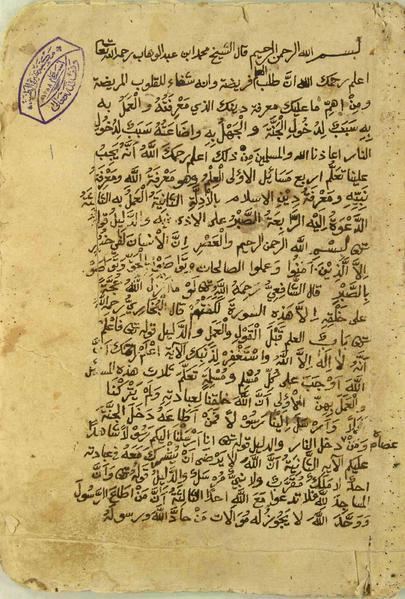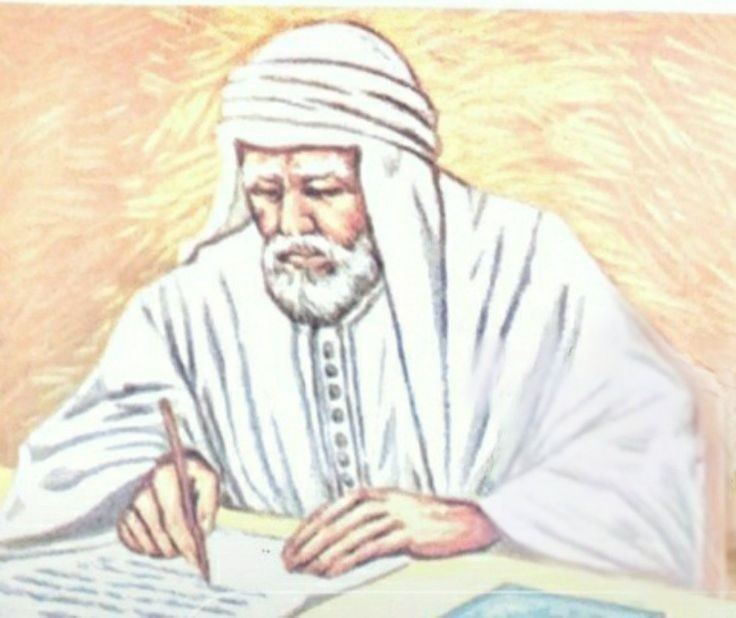Religion Islam Main interest(s) Aqeedah Era 18th century | Denomination Sunni Movement Wahhabi movement Name Muhammad Abd | |
 | ||
Born 1703 (aged 88-89), 'Uyayna, Najd Died July 20, 1792 (1206 AH) (aged 88-89), Emirate of Diriyah Books The Book of the Unity of God, Kitab At-Tawheed Explained Children Ali ibn Muhammad ibn Abd al-Wahhab Parents Bint Mohamed bin Azaz bin Al Mashrafi, Abdel-Wahab bin Soliman bin Ali Similar People Ibn Taymiyyah, Abd al‑Aziz ibn Baz, Ahmad ibn Hanbal, Muhammad ibn al Uthaymeen, Muhammad Nasiruddin al‑Albani | ||
Abu khadeejah new biography of muhammad ibn abd al wahhab
Muhammad ibn ʿAbd al-Wahhab (/wəˈhɑːb/; Arabic: محمد بن عبد الوهاب; 1703 – 22 June 1792) was a Sunni Muslim preacher and scholar from Nejd in central Arabia who claimed to "purify" Islam by returning it to what, he believed, were the original principles of that religion as the salaf, that is first three generations of Muslims, understood it. He rejected certain common Muslim practices which he regarded as amounting to either religious innovation (bid‘ah) or polytheism (shirk).
Contents
- Abu khadeejah new biography of muhammad ibn abd al wahhab
- The Wahabi Myth The Life of Muhammad ibn Abdul Wahhab Jalal Abualrub
- Early years
- Early preaching
- Pact with Muhammad bin Saud
- Emirate of Diriyah First Saudi State
- Family
- Teachings
- On Sufism
- Non Muslims
- By contemporaries
- By modern scholars
- Namesake
- Works
- References

Ibn 'Abd al-Wahhab's pact with Muhammad bin Saud helped to establish the Emirate of Diriyah, the first Saudi state. and began a dynastic alliance and power-sharing arrangement between their families which continues to the present day in the Kingdom of Saudi Arabia. The Al ash-Sheikh, Saudi Arabia's leading religious family, are the descendants of Ibn ʿAbd al-Wahhab, and have historically led the ulama in the Saudi state, dominating the state's clerical institutions.

His movement is today often known as "Wahhabism", although many adherents see this as a derogatory term coined by his opponents, and prefer it to be known as the Salafi movement. Many scholars claim that Salafism is a term applicable to several forms of puritanical Islam in various parts of the world, while Wahhabism refers to the specific Saudi school, which is seen as a more strict form of Salafism. According to Ahmad Moussalli, professor of political science at the American University of Beirut, "As a rule, all Wahhabis are Salafists, but not all Salafists are Wahhabis". Yet others say that while Wahhabism and Salafism originally were two different things, they became practically indistinguishable in the 1970s. 20th century Albanian scholar Nasiruddin Albani refers his activism to as "Najdi da'wah."

The Wahabi Myth - The Life of Muhammad ibn Abdul Wahhab - Jalal Abualrub
Early years

Ibn ʿAbd al-Wahhab is generally acknowledged to have been born in 1703 into the sedentary Arab clan of Banu Tamim (the Banu Tamim were not a nomadic tribe) in 'Uyayna, a village in the Najd region of the modern Saudi Arabia.
He was thought to have started studying Islam at an early age, primarily with his father, ʿAbd al-Wahhab, as his family was from a line of scholars of the Hanbali school of jurisprudence.
Ibn ʿAbd al-Wahhab reportedly spent some time studying with Muslim scholars in the cities of Mecca and Medina after performing Hajj, notably Mohammad Hayya Al-Sindhi. and in Basra (in southern Iraq).
Mohammad Ibn Abd-al-Wahhab's teacher Abdallah ibn Ibrahim ibn Sayf introduced the relatively young man to Mohammad Hayya Al-Sindhi in Medina and recommended him as a student. Mohammad Ibn Abd-al-Wahhab and al-Sindhi became very close and Mohammad Ibn Abd-al-Wahhab stayed with him for some time. Scholars have described Muhammad Hayya as having an important influence on Mohammad Ibn ʿAbd-al-Wahhab, who taught Ibn ʿAbd al-Wahhab to utilize informed individual analysis (ijtihad). Muhammad Hayya also taught Mohammad Ibn ʿAbd-al-Wahhab to reject popular religious practices associated with walis and their tombs that resembles later Wahhabi teachings. Muhammad Hayya and his milieu are important for understanding the origins of at least the Wahhabi revivalist impulse.
Following his early education in Medina, Abdul Wahhab traveled outside of the peninsula, venturing first to Basra.
Early preaching
After his return home, Ibn ʿAbd al-Wahhab began to attract followers, including the ruler of 'Uyayna, Uthman ibn Mu'ammar. With Ibn Mu'ammar, Ibn ʿAbd al-Wahhab came to an agreement to support Ibn Mu'ammar's political ambitions to expand his rule "over Najd and possibly beyond", in exchange for the ruler’s support for Ibn ʿAbd al-Wahhab's religious teachings. ʿAbd al-Wahhab began to implement some of his ideas for reform. First, citing Islamic teachings forbidding grave worship, he persuaded Ibn Mu'ammar to help him level the grave of Zayd ibn al-Khattab, a companion of Muhammad, whose grave was revered by locals. Secondly, he ordered the cutting down of trees considered sacred by locals, cutting down "the most glorified of all of the trees" himself. He is known to have organised the stoning of a woman who confessed to having committed adultery.
These actions gained the attention of Sulaiman ibn Muhammad ibn Ghurayr of the tribe of Bani Khalid, the chief of Al-Hasa and Qatif, who held substantial influence in Najd. Ibn Ghurayr threatened Ibn Mu'ammar with denying him the ability to collect a land tax for some properties that Ibn Mu'ammar owned in Al-Hasa if he did not kill or drive away Ibn ʿAbd al-Wahhab. Consequently, Ibn Mu'ammar forced Ibn ʿAbd al-Wahhab to leave.
Pact with Muhammad bin Saud
Upon his expulsion from 'Uyayna, Ibn ʿAbd al-Wahhab was invited to settle in neighboring Diriyah by its ruler Muhammad bin Saud. After some time in Diriyah, Muhammad ibn ʿAbd al-Wahhab concluded his second and more successful agreement with a ruler. Ibn ʿAbd al-Wahhab and Muhammad bin Saud agreed that, together, they would bring the Arabs of the peninsula back to the "true" principles of Islam as they saw it. According to one source, when they first met, bin Saud declared:
"This oasis is yours, do not fear your enemies. By the name of God, if all Nejd was summoned to throw you out, we will never agree to expel you."
Muhammad ibn ʿAbd al-Wahhab replied:
"You are the settlement's chief and wise man. I want you to grant me an oath that you will perform jihad (Struggle to spread Islam) against the unbelievers. In return you will be imam, leader of the Muslim community and I will be leader in religious matters."
The agreement was confirmed with a mutual oath of loyalty (bay'ah) in 1744. Ibn Abd al-Wahhab would be responsible for religious matters and Ibn Saud in charge of political and military issues. This agreement became a "mutual support pact" and power-sharing arrangement between the Al Saud family, and the Al ash-Sheikh and followers of Ibn ʿAbd al-Wahhab, which has remained in place for nearly 300 years, providing the ideological impetus to Saudi expansion. Karen Armstrong insists that the House of Saud has distorted his methodology of education, study and debate as the only legitimate means of da'wah to a violent political struggle.
Emirate of Diriyah (First Saudi State)
The 1744 pact between Muhammad bin Saud and Muhammad ibn ʿAbd al-Wahhab marked the emergence of the First Saudi State, the Emirate of Diriyah. By offering the Al Saud a clearly defined religious mission, the alliance provided the ideological impetus to Saudi expansion. First conquering Najd, Saud's forces expanded the Salafi influence to most of the present-day territory of Saudi Arabia, eradicating various popular practices akin to polytheism and propagating the doctrines of ʿAbd al-Wahhab.
Family
According to some sources while in Baghdad, Ibn ʿAbd al-Wahhab married an affluent woman. When she died, he inherited her property and wealth. This claim of marriage to "wealthy woman" and traveling to Baghdad is challenged by Salafi scholars who assert that his marriage was arranged by his father when he was a teenager and he never traveled beyond Basra. Muhammad ibn 'Abd Al-Wahhab had six sons; Hussain, Abdullah, Hassan, Ali and Ibrahim and Abdul-Aziz who died in his youth. All his surviving sons established religious schools close to their homes and taught the young students from Diriyah and other places.
The descendants of Ibn ʿAbd al-Wahhab, the Al ash-Sheikh, have historically led the ulama in the Saudi state, dominating the state's religious institutions. Within Saudi Arabia, the family is held in prestige similar to the Saudi royal family, with whom they share power, and has included several religious scholars and officials. The arrangement between the two families is based on the Al Saud maintaining the Al ash-Sheikh's authority in religious matters and upholding and propagating Salafi doctrine. In return, the Al ash-Sheikh support the Al Saud's political authority thereby using its religious-moral authority to legitimise the royal family's rule.
Teachings
See also Salafi and Wahhabi movement.Muhammad ibn ʿAbd al-Wahhab considered his movement an effort to purify Islam by returning Muslims to what, he believed, were the original principles of that religion, as typified by the Salaf and rejecting, what he regarded, as religious innovations (Bid‘ah) and polytheism (Shirk). He taught that the primary doctrine of Islam was the uniqueness and unity of God (Tawhid). The first aspect of tawhid is belief in Allah and His Lordship, that He alone is the believer's lord (Rabb). The second is the oneness of worship to Allah and Allah alone. The third being belief and affirmation of Allah's Names and Attributes.
The "core" of Ibn ʿAbd al-Wahhab's teaching is found in Kitab al-Tawhid, a short essay which draws from material in the Quran and the recorded doings and sayings (hadith) of the Islamic prophet Muhammad. It preaches that worship in Islam includes conventional acts of worship such as the five daily prayers (salat); fasting (sawm); supplication (Dua); seeking protection or refuge (Istia'dha); seeking help (Ist'ana and Istighatha) of Allah.
Muhammad Ibn ʿAbd al-Wahhab was keen on emphasizing that other acts, such as making dua or calling upon/supplication to or seeking help, protection or intercession from anyone or anything other than Allah, are acts of shirk and contradict the tenets of tawhid and that those who tried would never be forgiven.
Although all Muslims pray to one God (Allah), the highlight of this movement was that no intercession with God was possible; Muhammad strictly advocated takfir of those who considered themselves Muslim but were actually (Ibn Abdul-Wahhab believed) polytheists (mushrikeen). However, he avoided blanket takfir to all groups. In this regard he said "I do not say that one who prostrates on the grave of Abdul-Qadir Gilani unknowingly, has done shirk, but the one has done knowingly has."
On Sufism
Although highly critical of the Sufi practice of tawassul, at the end of his treatise, Al-Hadiyyah al-Suniyyah, Muhammad Ibn ʿAbd al-Wahhab's son ‘Abd Allah speaks positively on the practice of tazkiah (purification of the inner self).
Non-Muslims
According to author Dore Gold, in Kitab al-Tawhid, Ibn Abd al-Wahhab described followers of both the Christian and Jewish faiths as sorcerers who believed in devil worship, and cited a hadith of the prophet stating that punishment for the sorcerer is `that he be struck with the sword.` Wahhab asserted that both religions had improperly made the graves of their prophet into places of worship and warned Muslims not to imitate this practice. Wahhab concluded that `The ways of the people of the book are condemned as those of polytheists.`
However author Natana J. DeLong-Bas defends Wahhab, stating that
despite his at times vehement denunciations of other religious groups for their supposedly heretical beliefs, Ibn Abd al Wahhab never called for their destruction or death. … he assumed that these people would be punished in the Afterlife …"
By contemporaries
As with the early Salafists, Ibn ʿAbd al-Wahhab's teachings were criticized by a number of Islamic scholars for disregarding Islamic history, monuments, traditions and the sanctity of Muslim life. His own brother, Sulayman, was particularly critical, claiming he was ill-educated and intolerant, classing Ibn ʿAbd al-Wahhab's views as fringe and fanatical. It is generally believed, however, that the two later reconciled. A list of scholars with opposing views, along with names of their books and related information, was compiled by the Islamic scholar Muhammad Hisham.
By modern scholars
Pakistani Muslim scholars such as Israr Ahmed have spoken positively on him. Ibn ʿAbd al-Wahhab is accepted by Salafi scholars as an authority and source of reference.
Namesake
The state mosque of Qatar is named after him. The "Imam Muhammad ibn Abd al-Wahhab Mosque" was opened in 2011, with the Emir of Qatar presiding over the occasion.
Works
1- تاریخ آل سعود- ناصرالسعید- ص33
2- الدرر السنیه فی الرد علی الوهابیه، ص42
3- الدرر السنیه فی الرد علی الوهابیه، ص39
4- کشف الارتیاب، ص34- 35 اندکی تلخیص
5- تاریخ آل سعود ناصر السعید، ص26
6- کشف الارتیاب، ص
